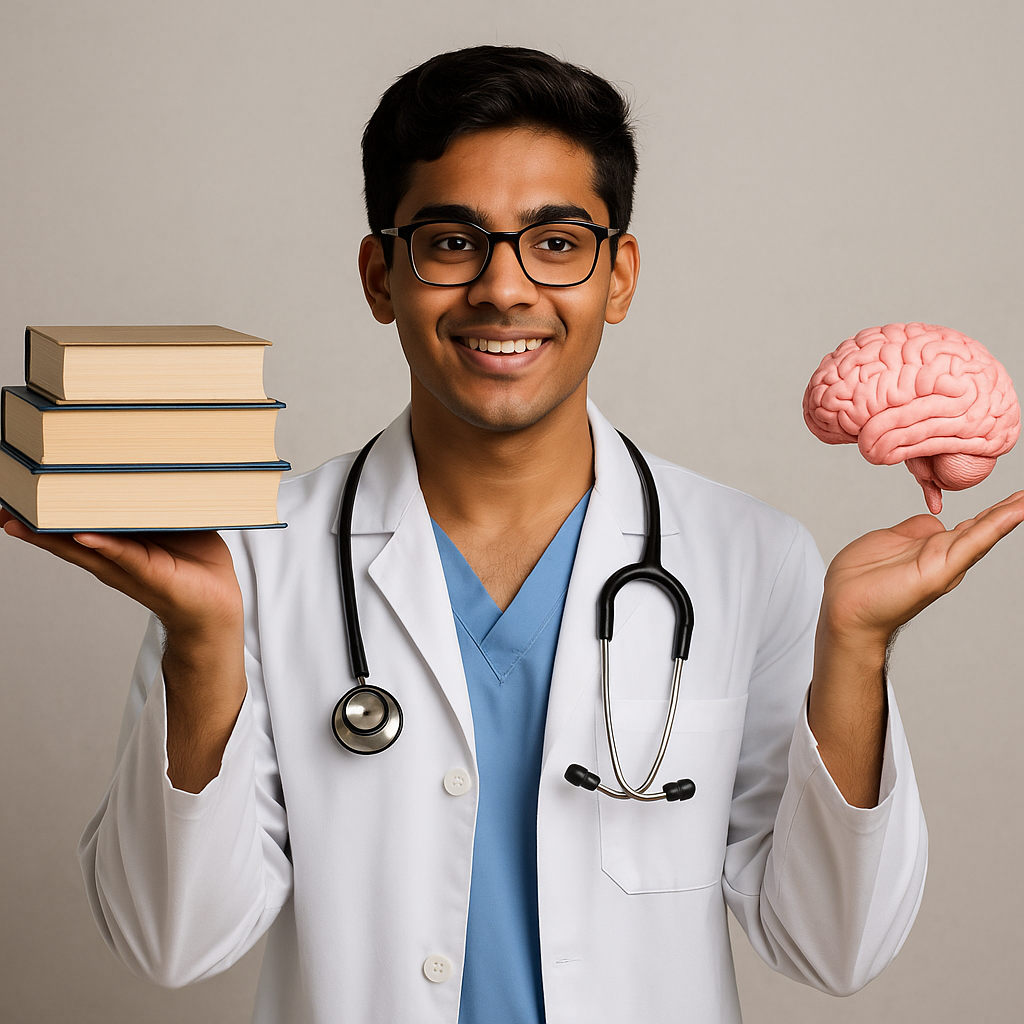
Medical education is a demanding journey that can significantly affect the mental health of medical students. Balancing rigorous academics, clinical training, and personal responsibilities places immense psychological strain on those in the faculty of medicine. Research shows that mental health challenges are widespread within the medical student population, often exacerbated by the unique culture of the field. Prioritizing mental health is crucial—not only for success in medical school, but also for future physicians aiming to deliver optimal patient care. Why is this emphasis so essential today?

Across the globe and within the United States, mental health challenges among medical students are alarmingly common. Studies indicate that high rates of depression, anxiety, and psychological distress are present in this group, with prevalence rates of depression and anxiety reaching as high as 27% and 34%, respectively. The pressures of medical culture—including perfectionism, academic performance demands, and exposure to suffering—contribute to these concerning figures.
The medical student population faces unique risks that are reinforced by the environment of medical education. Transition points, such as starting school or clinical rotations, often worsen mental stress. The relentless pace and expectations can create feelings of inadequacy and emotional distress. What are the most common mental health challenges faced by medical students during their training? Let’s explore these key issues more closely.
Medical students in the U.S., particularly in areas like Houston, TX, frequently experience mental stress and emotional distress during their training. These challenges can manifest as depressive symptoms, anxiety, and general psychological stress. The demands of academic performance, uncertainty about the future, and the pressure to excel contribute to the higher incidence of mental illness in this population.
One of the most significant mental health challenges is burnout, characterized by emotional exhaustion and cynicism. Students often report sleep deprivation, feelings of inadequacy, and fear of making mistakes. According to a 2023 study, over 60% of students at U.S. medical schools reported depressive or anxiety symptoms during the COVID-19 pandemic, with many attributing their struggles to the intense curriculum and clinical exposures.
In Houston-based schools, the combination of financial debt, lack of control over schedules, and continual exposure to illness and death intensifies psychological distress. Medical culture, with its focus on perfectionism, can further discourage students from acknowledging their struggles or seeking help when needed.
Mental health challenges among medical students are not confined to the United States—they are a global phenomenon. Persistent issues such as depression, anxiety, and psychological distress are reported in medical faculties worldwide. International studies suggest that 40-50% of medical students experience significant emotional disturbances during their training years.
Locally, Houston, TX, reflects these global patterns but adds layers unique to the region. Economic pressures, diverse patient populations, and the aftermath of the COVID-19 pandemic have left many students in Houston struggling with mental health. National and world events like World Mental Health Day are helping to raise awareness, but persistent cultural barriers still limit students’ willingness to seek support.

These statistics underscore a universal need for better psychological support and a culture shift toward mental health awareness.
Several underlying factors contribute to psychological distress among medical students. From academic pressure to the emotional toll of clinical training, each element compounds stress and heightens vulnerability to mental health issues. Academic performance demands and rigorous curriculum structures often leave little time for self-care or recovery from setbacks.
The transition into clinical rotations introduces students to trauma, ethical challenges, and high-stakes environments, leading to emotional exhaustion. These combined pressures make managing mental health especially complex within medical education. How does the rigorous academic environment in medical school impact students’ well-being?
Academic pressure is a defining feature of medical education. Students in the faculty of medicine must master vast quantities of information, perform well in assessments, and compete for coveted residency placements. This relentless focus on academic performance can create feelings of inadequacy and chronic stress, even among high-achieving students.
Many report difficulty managing time and prioritizing self-care, leading to emotional distress and decreased overall well-being. The fear of failure or appearing less competent than peers amplifies anxiety. Perfectionism, a common trait in medical culture, can worsen these feelings. As Carl Jung once said, “Perfection belongs to the gods; the most we can hope for is excellence.”
Medical schools in the United States, including those in Houston, often recognize these challenges but struggle to provide adequate stress management support. Without proper guidance, students may turn to unhealthy coping mechanisms, such as substance use or social withdrawal, which only compounds their difficulties.
Clinical rotations introduce a new set of stressors. Students are frequently exposed to suffering, death, and the limitations of medical intervention. These experiences can lead to emotional exhaustion, ethical dilemmas, and moral injury—a type of psychological distress resulting from actions that conflict with personal values.
During clinical years, the loss of control over schedules and increased responsibility can heighten stress levels. Students report increased anxiety, irritability, and struggles balancing professional demands with personal life. The emotional impact of witnessing trauma or making mistakes can linger, often unaddressed due to the stigma around vulnerability in medical culture.
Medical schools are exploring resilience training, peer support, and mindfulness as potential solutions. However, the persistent emotional demands of clinical rotations still pose a significant threat to student well-being and underscore the need for systemic change.

Stigma remains a powerful barrier to mental health awareness and treatment among medical students. Many worry about being perceived as weak or unfit for medical practice if they disclose psychological struggles. This fear, coupled with concerns about future career progression, discourages students from seeking help, even in the face of significant distress.
Medical education is gradually acknowledging the importance of mental health, yet stigma persists. How do medical schools address stigma around seeking mental health support among their students? The following sections explore the barriers and new initiatives aimed at reducing stigma.
Despite knowing the risks, current medical students often hesitate to access mental health services. Key barriers include:
Psychological stress is further compounded by the internalized expectation that doctors should be “invincible.” Students may ignore warning signs of emotional distress, believing that managing stress independently is a professional requirement. Stigma also extends to peer interactions, with some students fearing judgment from classmates or faculty for seeking mental health care.
While some progress has been made, these persistent barriers can prevent timely intervention and lead to worsening mental health issues. Addressing these obstacles is essential for cultivating a healthier, more supportive learning environment in medical education.
Medical schools are starting to launch initiatives aimed at normalizing mental health awareness and support. Efforts include:
Peer support programs have proven especially effective, allowing students to recognize struggling colleagues and collaborate on solutions. Schools are also working to clarify policies surrounding confidentiality and treatment access, making it easier for students to seek help without fear.
These initiatives are changing the culture of medical education bit by bit. However, ongoing efforts are needed to fully destigmatize mental health treatment and ensure all students can access the care they need.
Unchecked stress and burnout can have serious consequences for future physicians. High levels of emotional distress and exhaustion lead to decreased empathy, impaired performance, and even increased risk of medical errors. Medical students who neglect self-care or fail to manage stress are more likely to experience long-term psychological and physical health issues.
Preventing burnout is not only about ensuring success during medical school, but also about safeguarding the ability of future doctors to provide compassionate, effective care. How can medical students effectively manage stress and prevent burnout throughout medical school?
Spotting the early warning signs of stress and burnout is critical. Common indicators include:
Medical students should be encouraged to monitor their own well-being and look out for these signs in classmates. Stress management strategies, such as mindfulness, regular exercise, and maintaining social connections, can be helpful in preventing and addressing burnout.
Early intervention through peer or faculty support, counseling, and structured self-care routines can make a significant difference. By normalizing these conversations within medical culture, students can learn to manage stress proactively and build resilience for the demands of their future careers.
Chronic psychological distress in medical school can shape a physician’s entire professional journey. Burnout, if unaddressed, is linked to higher rates of job dissatisfaction, medical errors, and even physician suicide—a reality that claims around 400 doctors annually in the United States. “We burn out, we break, we die: medical schools must change their culture to preserve medical student mental health,” writes CT Veal, highlighting the urgent need for reform.
Personal lives also suffer, with strained relationships, poor physical health, and substance use issues emerging as lingering effects. Over time, the inability to manage emotional distress can erode empathy and impair a physician’s ability to provide quality care, ultimately impacting patient outcomes.
Prioritizing mental health from the outset of medical training is essential not just for academic success, but for sustaining a fulfilling career and a balanced, healthy personal life.
Research consistently shows that medical students experience higher rates of psychological distress compared to their peers in the general population and other academic fields. The combination of academic rigor, exposure to trauma, and a culture of perfectionism sets medical training apart.
While students in other graduate programs face stress, those in medicine often report more severe symptoms of anxiety, depression, and burnout. How does mental health among medical students compare to that of students in other academic fields? The following sections will highlight the unique challenges and risk factors in medicine.
Medical education is distinct from other graduate programs in its expectations, length, and intensity. Students face a relentless flow of examinations, clinical rotations, and high-stakes decision-making. These factors create a unique environment where imposter syndrome and psychological stress are common.
Unlike other fields, medical students must grapple with life-and-death situations and the emotional weight of patient care. The culture of medicine also places a premium on stoicism and self-sacrifice, making it harder for students to seek help or admit to struggles.
Studies indicate that while stress and mental illness occur across all disciplines, the persistence and severity are often higher among medical students. This underscores the need for tailored mental health interventions specifically within the faculty of medicine.
Certain protective factors can help buffer against psychological distress. Strong social support, easy access to mental health resources, and resilient coping skills are all associated with better outcomes for student well-being. Peer support groups and mentor networks have shown to increase feelings of belonging and reduce the impact of stress.
Conversely, risk factors such as academic overload, lack of sleep, and unclear access to mental health services can worsen mental health outcomes. Students lacking these supports are at increased risk for depression, anxiety, and burnout.
Medical schools are encouraged to offer a range of support services, including counseling, wellness programs, and crisis management training. What mental health support services and resources are typically available to medical students? Let’s look at the options available, especially in Texas.

In Texas, medical schools are expanding mental health services to address rising rates of depression, anxiety, and burnout among their students. Resources typically include on-campus counseling, confidential support lines, and access to mental health care providers covered by insurance. The Association of American Medical Colleges encourages these services as a foundational part of student support.
Despite growing awareness, gaps remain in resource availability and accessibility. Schools are working to ensure that support services meet AAMC recommendations and are easy for students to navigate.
On-campus counseling services are a primary mental health resource for Texas medical students. These services offer confidential support, mental health care, and connections to professionals who understand the unique pressures of medical education. Key features include:
Most medical schools partner with insurance providers, allowing students to access mental health treatment with minimal financial burden. However, waitlists and limited hours can still pose barriers, highlighting the need for expanded service capacity.
In addition to in-person care, many schools now offer online resources and helplines for students seeking anonymity or flexible access. Ensuring confidentiality is a top priority, helping to reduce the stigma associated with seeking help for psychological distress.
Peer support and mentor networks are vital for medical students’ emotional well-being. These programs connect students with trained peers and experienced faculty members who can provide guidance, validation, and practical advice. Effective peer support initiatives often include:
Such programs create a sense of community, helping students feel less isolated in their struggles. They also promote early recognition of mental health issues, enabling faster intervention.
Peer support not only helps individuals but also strengthens the overall culture of care within medical schools. By sharing experiences and strategies, students can build resilience and support each other throughout their training.
Promoting mental well-being requires a proactive approach combining individual responsibility and institutional support. Medical students are encouraged to adopt healthy habits, effective stress management techniques, and prioritize sleep quality to maintain their mental health. Schools can reinforce these strategies by embedding wellness resources within the curriculum.
Are there specific self-care strategies that medical students can use to maintain their mental health? The next sections offer evidence-based practices and practical tips for balancing the demands of medical education.
Research supports several self-care and stress management techniques for medical students. Effective strategies include:
Access to counseling and peer support groups further enhances resilience. Students are encouraged to build time for relaxation, hobbies, and social connection into their routines. Evidence shows that these practices can lead to better academic performance, lower rates of burnout, and improved overall well-being.
Schools that promote these techniques as part of their culture help students integrate self-care into their daily lives, supporting sustainable success in medical training.
Effective time management is a cornerstone of well-being for medical students. Developing organizational skills, setting realistic goals, and creating structured study plans can reduce stress and prevent last-minute cramming, which is often linked to poor sleep quality and increased substance use.
Building healthy habits goes beyond academics. Students should prioritize balanced nutrition, regular exercise, and consistent sleep schedules. Avoiding reliance on stimulants or other substances to cope with stress is critical for maintaining both mental and physical health.
Schools can support these efforts by providing workshops and resources on time management, self-care, and resilience. By modeling healthy behaviors and encouraging open dialogue, faculty and staff can help students establish routines that promote long-term well-being.
In conclusion, understanding and addressing mental health challenges in medical school is crucial for the well-being of future physicians. With the unique pressures faced by medical students, including academic rigor and the emotional toll of clinical rotations, it’s essential to foster an environment that prioritizes mental wellness. By recognizing the signs of stress and burnout, utilizing available support services, and implementing effective self-care strategies, students can better navigate their demanding educational paths. Remember, seeking help is a strength, not a weakness. If you need assistance, don't hesitate to reach out for guidance from professionals who understand your journey.
Riaz Counseling in Texas accepts insurance from various providers, including BCBS of Texas, Optum, Magellan, Aetna, Cigna, and others. This wide range ensures that many individuals can access the mental health services they need without financial strain.
Premed students can build mental health awareness and resilience by adopting stress management strategies early, learning about common mental health challenges in medical training, and seeking support networks. Preparing emotionally and academically can ease the transition and help manage upcoming stressors.
Disclosing a mental health concern on a medical school application can be sensitive. While stigma and psychological distress are real concerns, many schools support applicants who seek mental health services. Applicants should weigh the potential impact and seek guidance from advisors or mental health professionals.
If you notice signs of burnout or emotional distress in yourself or classmates, reach out for peer support, utilize available stress management resources, and seek professional mental health care when needed. Early intervention and open communication are key to preventing further complications.
If you feel that you or someone you know, may benefit from therapy, please reach out to our office for a FREE 15 minute consultation: LINK.
Stay informed about the latest research in psychology.
.png)
A practical guide to recognizing, treating, and finding professional support for seasonal depression in Houston, despite its sunny climate.

Recognize the signs of seasonal depression in Houston and learn when to seek professional help, including effective treatment options and support from Riaz Counseling.
.png)
A clear guide to understanding how Seasonal Affective Disorder is diagnosed in Houston, including key symptoms, DSM-5 criteria, and when to seek professional support.